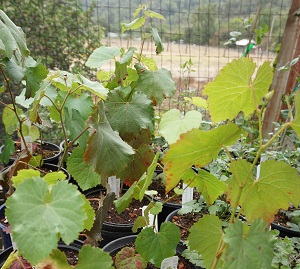Two of the great vines available at the nursery are Vitis californica (California wild grape) and Clematis lasiantha (chaparral clematis). They are both useful habitat plants and can be grown as a ground cover or trained over a trellis or fence. They are tolerant of a wide variety of soils -- from clay to sandy soils.
Clematis lasianta (Chaparral clematis)
 Clematis lasianta, which is also known as chaparral or pipestem clematis, is a lovely vine that is covered with gorgeous white flowers in the spring. The flowers are followed by fluffy white seed heads that make the plants look like they're covered in cottonballs. It can grow fifteen to twenty feet tall. This plant loves full sun although it prefers some shade for its roots. It does not need supplemental water after it is established. It is deciduous and may die back in cold winters, but will quickly grow back in the spring. You can see these vines in flower on many local trails in the spring.
Clematis lasianta, which is also known as chaparral or pipestem clematis, is a lovely vine that is covered with gorgeous white flowers in the spring. The flowers are followed by fluffy white seed heads that make the plants look like they're covered in cottonballs. It can grow fifteen to twenty feet tall. This plant loves full sun although it prefers some shade for its roots. It does not need supplemental water after it is established. It is deciduous and may die back in cold winters, but will quickly grow back in the spring. You can see these vines in flower on many local trails in the spring.
More at Las Pilitas and Calflora.
Vitis californica (California wild grape)

Vitis californica has beautiful, large green leaves that provide an excellent cover in the summer. In the wild, it is typically found along streams and other moist areas, but is adaptable to dry conditions after it is established. It is a deciduous vine that can grow over thirty feet tall. Since it sheds its leaves in the winter, it's great over an arbor or trellis for summer shade and winter sun. It produces bunches of small purple grapes in the fall. The grapes are edible, but tend to be tart.
Maintenance is easy. Agi Kehoe, an active member of the Gardening With Natives subgroup shares these simple pruning instructions:
Winter pruning: thin out the vine by removing all but the major canes that form the structure. Once finished, there should be one mature cane per wire line on a fence, and maybe 3 canes on a 2' wide arbor. Cut the canes back to 2-3 buds, each cut should be 1/4" above the leaf node. This is also the time to secure the large canes to the trellis with ties.
Active growing season pruning: maintain the fast growth. If trained on a fence, prune to keep it close to the fence; if trained on an arbor, leave some fresh green canes hanging down from the arbor to create a softer look.
More at Las Pilitas Nursery and Calflora.

